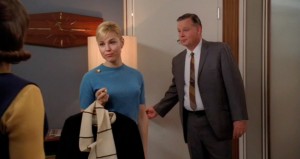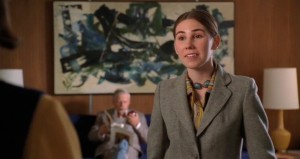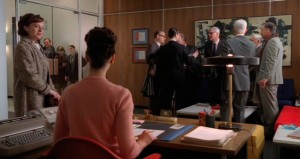Selling Style: Mad Men and the Fashioning of Femininity
“The Rejected” has quickly become one of my favorite Mad Men episodes. Those through-the-glass-doors looks between Peggy and Pete! Peggy peaking through the window into Don’s office! Allison glancing furtively (or is it pointedly?) across the two-way mirror during the focus group and then shattering the glass frames while telling Don, “You’re not a good person”! This is an episode filled with glass surfaces, reflections, talk of looking at oneself and shots of looks between characters both open and secret. It is also an episode in which how the characters look was central to the meanings on offer.
Mad Men is a series frequently praised and sometimes criticized for its lush visual style. Foremost in the attention paid to the program’s style is its mise-en-scene—the sets, the props, the hair, make-up, and costumes. While this retro style is certainly one of the fun elements of Mad Men viewing, its presence is never mere style for style’s sake. A basic lesson in the analysis of media texts is the awareness that all on-screen elements are there for a reason; they have been chosen deliberately and they thereby communicate meaning. Mad Men’s vintage setting and generous budget may make its style particularly compelling, but for me—and perhaps for many other of the show’s admiring viewers—the attention to how things and people look is key to the show’s exploration of gender roles so precariously perched on the edge of disruption and change.
“The Rejected” in particular uses the way the characters look to map out some of the ways that femininity, and the kind of sexuality normatively associated with it, is on the verge of change. The young SCDP secretaries that make up the focus group are garbed in the dresses, jewelry, updo’s, and hair height we associate with the “fifties” part of the 1960s. Sure, there is a range of looks amongst them—the more juvenile Dotty and Allison in their plaid, the Joan-wannabe Megan in her curve-enhancing jewel tones—but together they represent a traditional young femininity.  This femininity sees marriage as the ultimate goal. Or so concludes Dr. Faye Miller, the educated, professional, (married) market researcher. But Faye sees herself as a different kind of woman. She changes her clothes to lead the focus group, abandoning her more businesslike jacket and scarf for a look more akin to the secretaries, hoping to induce a greater degree of revelation from her test subjects
This femininity sees marriage as the ultimate goal. Or so concludes Dr. Faye Miller, the educated, professional, (married) market researcher. But Faye sees herself as a different kind of woman. She changes her clothes to lead the focus group, abandoning her more businesslike jacket and scarf for a look more akin to the secretaries, hoping to induce a greater degree of revelation from her test subjects .
.
But the really new femininity introduced in “The Rejected” belongs to Joyce Ramsay, the new friend who takes Peggy into a hipster world of Warhol-worshipping, pot-smoking adventure. Joyce does not look like any of the other women in the Mad Men world. She wears a men’s style blazer and button-down shirt, her hair parted in the middle, laying flat against her head and secured in a low ponytail, her one piece of jewelry an “ethnic” looking turquoise necklace. And she wears pants. Pants. Joyce’s “unusual” vibe is further secured when she kisses (licks?) Peggy at the party. As usual, Peggy is the point of negotiation for these differing depictions, a position made clear as she stands amidst a triangle of options: Megan, the SDCP men in suits, and Joyce and her hipster gang.
While Mad Men uses its characters’ sartorial style in these thoughtful and revealing ways, AMC and the show producers are also aware of the marketing magic of the program’s fashion-savvy. Capitalizing on a broader cultural embrace of the program’s retro style, AMC has partnered with national retailer Banana Republic to sell “Mad Men Style” to the (upscale) mass market. In weekly vlogs, costume designer Janie Bryant chats with Banana Republic Creative Director Simon Kneen, who links the Mad Men look for both women and men to BR’s contemporary stock. Meanwhile, a weekly “Fashion File” blog post deconstructs that week’s looks, much as I have done here.
We can certainly see these sorts of marketing efforts as savvy exploitations of one of the program’s appeals. But I’m not convinced that these efforts detract from the value of the show’s use of fashion and style to explore femininity and masculinity in flux. A show that takes fashion seriously is also taking seriously a cultural arena long dismissed for its association with the feminine. To discount it as mere surface appeal or promotional wizardry risks duplicating that troubling rejection of the feminine. But to take fashion seriously in a way that also explores the limits of conventional gender roles and the welcome potential for feminist change, that helps us share in the looks of the Peggys, the Allisons, the Megans, and the Joyces as they try to find their way? Yes, please.



Intriguing take on this episode, which is thus far my favorite of the season, for all the reasons you analyzed.
Related to the comparative treatment of fashion and gender that we were invited to enjoin are the perpetual storm clouds of change. While change is of course what MM is ultimately “about,” it comes in different permutations in every episode. And here I think we were presented not just with change but with what the very process of change looks and feels like. Peggy’s arrival at the party was our most elaborate immersion in the “sixties” of the 1960s yet in MM, and her sense of wonder, bemusement, stoned fascination, and (during the police raid) excitement are indications of a growing comfort with the New (rather than a shocked rejection, as Life Magazine did with the photos; more on that below). Peggy’s realization of Malcolm X’s assassination–i.e., that “important stuff is going on”–similarly models a potential interest in “the stuff between the ads.” Allison’s explosion at Don was cathartic and messy: change is also loud, angry, and violent. On a less historiographic level, even Pete’s realization of fatherhood, and ballsy business offer to his father-in-law suggests a substantial personal change.
The sequence at the end was beautiful in this regard, as you observe, with an almost Kubrickian regard for Megan and the back-slapping ad men contrasting with the mocking Joyce et al on the other side of the glass. Tip of the hat to John Slattery, who directed this one; not just our sad Roger Sterling, apparently.
As for the “shocked” Life Magazine, how unintentionally ironic that these mild nudes were presaged by the full-screen “partial nudity” warning at the beginning of the episode. So we’re meant to giggle at Life’s shock in 1965 and accept as legitimate AMC’s paternalism in 2010. Hmmm…
The Peggy-centric episodes are always the best and “Rejected” marks a new high point.
I can see a bit of Kubrick here, Derek, but I think the better comparison — considering all the mirrored surfaces and windows that Elana mentions — is Sirk. Many of the MM women are trapped within 1950s conventions of femininity (cf. ALL THAT HEAVEN ALLOWS), but Peggy is charting her own course.
And John Slattery’s (!) use of mise-en-scene (the post in Pete’s office!) is taken from Sirk’s playbook.
I completely agree with your comments about the importance of fashion to the gender politics of the show. As the appearance of Joyce underscores, up until this point clothing has been one of the most visible ways for the show to express just how strictly gender norms were policed during this era. During the first two seasons, I was fascinated by how often we saw our female characters in their underwear, moments that were not only intending to titillate or to underline the attention to detail in the series (even the undergarments are period accurate!), but that show how women’s bodies literally were sculpted and hemmed in to conform to mid-century expectations about women’s roles and norms of beauty.
As per Derek’s comments about the episode’s integration of the “sixties” into the show, I have to admit that when Mad Men provides images of the counter-culture, I always squirm a little. The series has been so invested in presenting a counter-narrative to what we think of when we think of the sixties, that when it brings in characters or scenes that gesture to the youth movements or cultural changes of the period, it always seems to me to be presented with a healthy dose of condescension and disrespect, as though Weiner and his team don’t really take any of it seriously and revel a bit in exposing how silly it was. While I liked Midge a good deal, her Bohemian friends were caricatures, as were I thought the crowd at the Factory-like party where Joyce took Peggy. Stephanie, Anna’s niece who we met last week, similarly seemed ridiculous, as did the delinquent draft-dodgers of season three and the hippie-esque teacher Don slept with. I think show is on more solid ground when it uses shifts in advertising to think through changes in the culture of the 1960s, and the scenes inside the agency in which the characters have to grapple with how the world is changing read as much more persuasive than those in which the characters venture outside.
I also noticed the Malcolm X comment, which both spoke to Peggy’s increased consciousness of the political shifts of the era, and let the audience know that around two months had passed since the last episode (Malcolm X was murdered at the end of February). Since Allison and Don’s “indiscretion” happened around Christmas, this confrontation had been in the making for around two months
Thanks, Derek and Allison, for the thoughtful comments. I agree, Allison, with your sense of the cringe-worthiness of some of the counter-culture depictions in the series. But I thought Joyce, at least, was less of a caricature, perhaps because Peggy was so accepting of her. I did find the Malcolm X reference telling, too. I’m hoping it portends more attention to racial politics in the episodes ahead. So much going on in these episodes, it’s hard to deal with anywhere near all of it in one Antenna post!
Interesting about how you’re each finding the counter-culture depictions (at least a little) cringe-worthy. I could see that, but I’ve always seen those characterizations as both testing the sensibilities of our “establishment” regulars and testing our comparative hindsight (i.e., the historical construction of the “sixties,” which looms like a monolith over our viewing of the show).
I’d be disappointed if the counter-culture types were meant to be read as somehow more “authentic” or (worse) “real” than the regulars. Instead, I see Weiner et al pointing out that the ad men and women don’t have a monopoly on posturing and conformity; it comes in different varieties and angles. The denoument of the entire series (eventually, in a few years) may very well be when Joyce comes to work for Peggy’s hip new ad agency circa 1971, selling the counter-culture to the world as more products…which is basically what happened.